Features of level design on the example of Gardenscapes
Alexander Shilyaev, a leading game designer at the Gardenscapes project (Playrix), shared his experience in developing levels for games in the three-in-a-row genre.
The report was read at White Nights Moscow 2017. We have prepared a printed version of the speech.

Alexander Shilyaev
In this article, we will talk about the features of the level design in our project, about what requirements we impose on the levels, what problems we face when we do these levels, and also talk about the features of the influence of the bonus system on the level design.
All the topics raised in this report are based on our experience in developing Gardenscapes and, of course, on our gaming experience in other people’s match-3 games.
It is absolutely not necessary that the direct transfer of ideas from my report to your products will somehow significantly affect something. My report is rather that you can conduct a similar study on your project and change something in your approach to developing levels.
Let’s start with general information. Currently there are 34 modes, elements and mechanics in Gardenscapes. With the help of these modes and mechanics, we have created more than 1,650 levels.
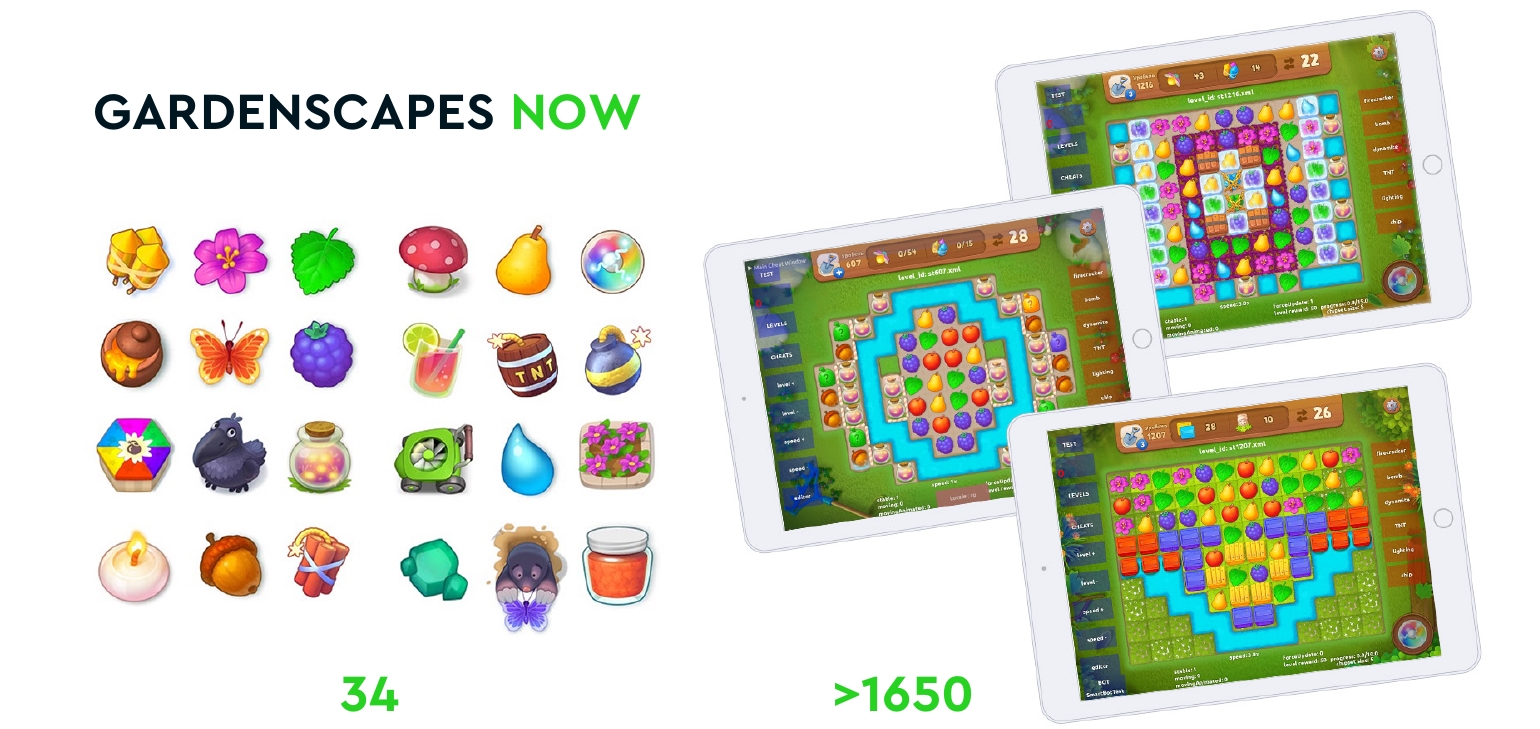
Initially, the team (level designers) consisted of three people. At the moment, when the game is a little more than a year in release, the team has increased to 11 people and continues to grow.
Every week we post 25 new levels for our players. In addition, we have dog training events, there are various festive events (here in the screenshot – Christmas, there were Easter events). And all this forces us to do a lot of levels.
We make so many levels that we sometimes get confused in them ourselves, but at the same time it is important to us that players do not get tired of match-3 mode and continue to have fun.

Not all levels in the game have to be very cool. It’s normal when a part of the levels does not stand out in any special way. There is even a plus in this, because against their background, steep levels will be remembered. But this does not mean that there should be few cool cool people.
How does the cool level differ from the usual level, which does not cause the player any emotions?
Level Ideas
We believe that the key to a cool level is the presence of an idea.
What is the match-3-level idea?
This is what distinguishes the level from the general chain, makes it special, allows the player to experience some new unique emotions when passing.
These sensations can be from:
- using mechanics;
- combinations of different mechanics;
- visualizations at the level;
- using the bonus system of your game;
- random elements and so on.
When the player understands what idea the level designer wanted to put into the level, he ceases to treat it as a field filled with obstacles. He sees it as a mini-task that he wants to solve, begins to feel emotions.
This is exactly what I see as the task of the level designer: to get emotions from the player when passing the level.
For clarity, let’s look at some examples – real levels from Gardenscapes.
Example one
The example is called “Using Reverse Mechanics”. In this level, the player must lower the lemonades from the top line to the bottom, but the departure of the lemonade is blocked by the so-called “Big Fireworks”. This is a helping bonus.

Initially, the mechanics of the “Big Fireworks” are auxiliary. But in this case we use it as a blocker. This reverse use of mechanics creates an interesting feeling for the player. He’s not used to this experience yet.
Example two
It can be called “Visualization”. Often we use the topology of the level to draw some symbols, silhouettes.

In this case, it is a rabbit. He looks cute. A player enters a level, sees such beauty there, and his mood rises, he wants to start playing with this level. And in this case, we supported the Easter theme in the main garden with such a rabbit.
Example three
The following example is the use of level bonuses. In the screenshot below, the level where it is necessary to withdraw lemonade is again taken as an example.

The player needs to bring the lemonade out of the four corners. To do this, he must use the accumulated bonus “lightning”.
In order to get a bonus, he must work with the central part of the field and collect big matches, collect big explosions, activating them.
Here we get a logical chain: the player makes a match, the player collects bonuses, the player explodes bonuses, accumulates lightning, and then collects lemonade.
Example four
The last example that can help you promote a player to emotion is related to randomness.

Here, only the central parts of the field are available to the player, where he can make matches. His task is to make matches and hope that there will be a patch in the side sections, collect fireflies and bring him closer to passing the level.
There is an idea behind all these levels.
The attitude of the subject plays a very important role in defining an idea. Someone thinks the level is good, someone thinks it is bad. There is no universal recipe.
How does the problem work?
There must be a person in your team whose opinion you trust. In the future, he should confirm this opinion with good metrics for retaining and monetizing levels.
Bonus system
In addition to ideas, the level design is strongly influenced by your bonus system.
There are a number of features that distinguish Gardenscapes from other top match-3. These are colorless bonuses (they have no binding to the type of chips). To activate them, you do not need to make matches with them: a double tap or swipe in any direction is enough. We also have a rechargeable lightning bonus that the player can collect at each level.
This bonus system allows us to make unusual levels for the genre.
Example one
I call it the “Active Beginning”. At the start of the level, the player is given two “lightning bolts” (you can see at the top of the screen). The player can make a very big explosion with the first swipe.
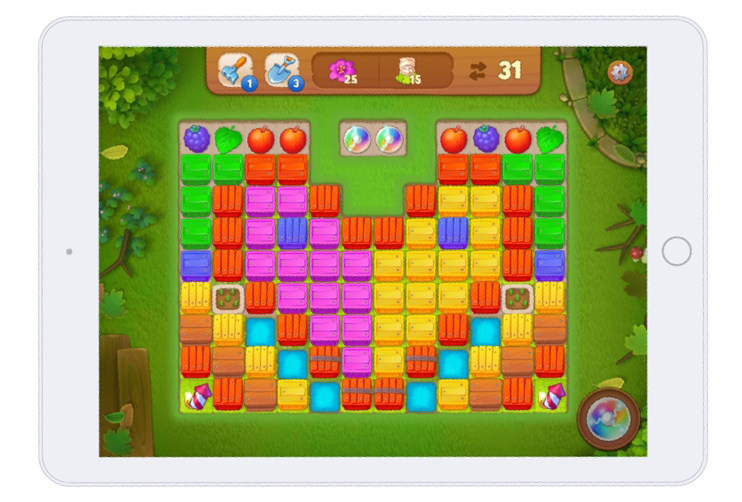
The blast wave will blow up almost all the obstacles on the field, and thus the player has made only one move, and the level has visually changed a lot. Progress on the level is already very significant, and the player continues to work with the level on such joyful feelings.
Example two
The next good example with bonuses is a level focused on explosions. At the level just below, the player constantly explodes various bonuses.

How does it work?
There are a number of preset bonuses. At the same time, there are few chips at the level, but it is configured in such a way that there are a lot of automatches on it (a lot of automatic bonus collections), and when a player blows up something (clears the field), there are even more matches, as well as bonuses. Such chains of explosions pass this level.
Element input logic
In addition to the bonus system, the input of elements also affects. Six months ago we switched to a new system of element inputs. Now we have divided all the elements into three groups: basic, incoming and “special”.
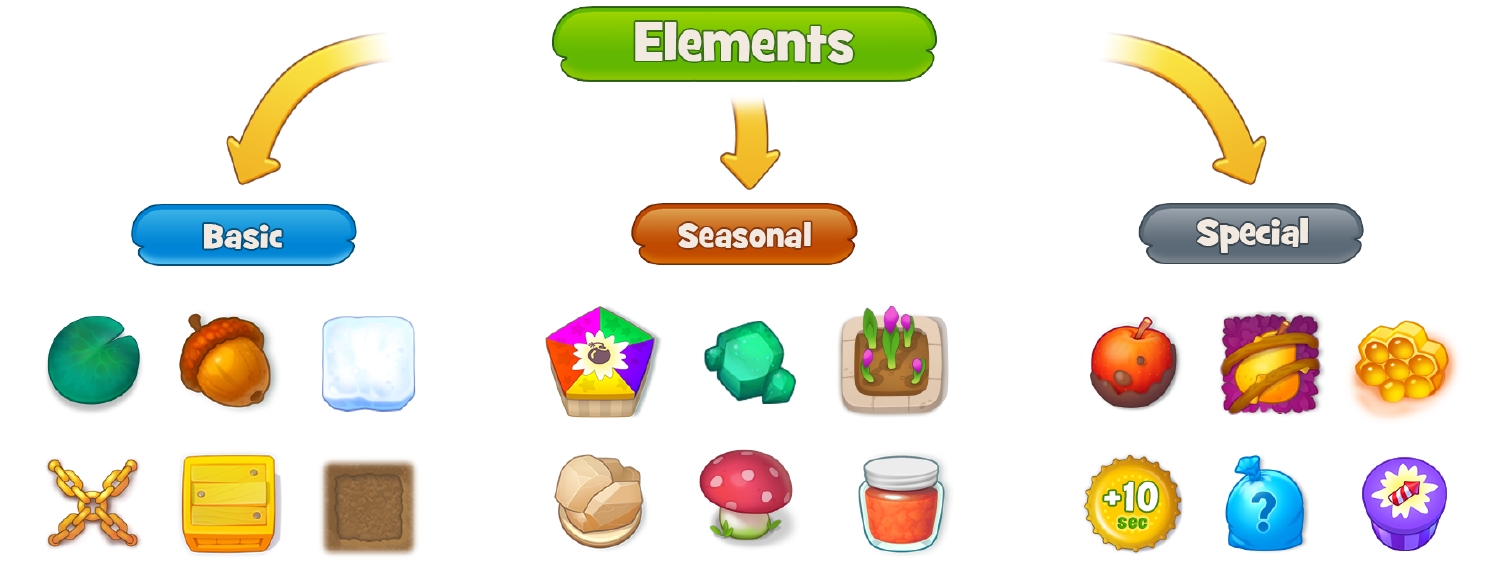
The basic elements are those elements that occur throughout the game.
Incoming elements meet at 3-6 levels in a row, then they “leave” the game for 20-25 levels.
A special element is something very unique, interesting, and most often complex. They are needed in order to create an interesting level and cause the player to have some new emotions.
Combination mechanic
Now let’s move on to the topic of combining mechanics. It is also a very big topic, which we are doing a lot.
What mechanics do we have in Gardenscapes?
- Blockers are elements that prevent a chip from occupying a specific tile (boxes, colored boxes).
- Active elements are elements that make their move after the player’s move (butterfly, float).
- Elements that change the field (for example, a water lily: you make a match, the water lily moves out, and the tile active for the player also moves with it).
- Portals are elements connecting several sections of the field.
- Generators are such elements, when interacting with which new elements are created (flowerbed, honeycomb).
- Helping elements are those elements that “help out” the player at the level (rockets, “Big fireworks”).
In real conditions, not all elements are combined with each other. To understand which element is combined, we make test levels, analyze, and subsequently prepare a special document on combinations. For each element, we have a written text with which this element can be combined. In the future, this document is transmitted to level designers, and when preparing levels, they use these developments. This allows us to avoid mistakes and maintain the requirements for the level. You can see good combinations in the game, I’ll tell you a little more about bad combinations.
An example of a bad combination that you won’t find in Gardenscapes is the “ivy” element on the right and the “honey” element on the left.
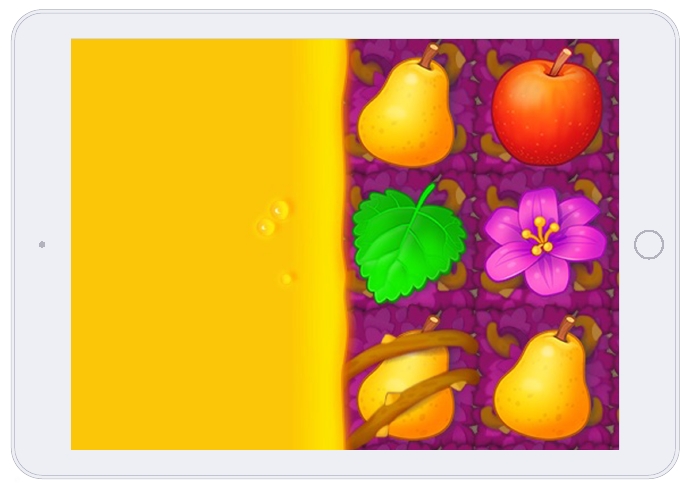
Both elements affect the tile. The ivy absorbs the chip, but not entirely, you can interact with the chip. Honey absorbs the chip entirely. But when we use these elements at the same level at the same time, they so actively start to “fight” for tiles that they already compete with each other. And this competition of elements with each other sometimes leads to a dead end and greatly increases the complexity of the element, so we simply refused from such a combination.
Another example is the rejection of a combination due to visualization. For example, we do not combine water lilies and jars of honey.
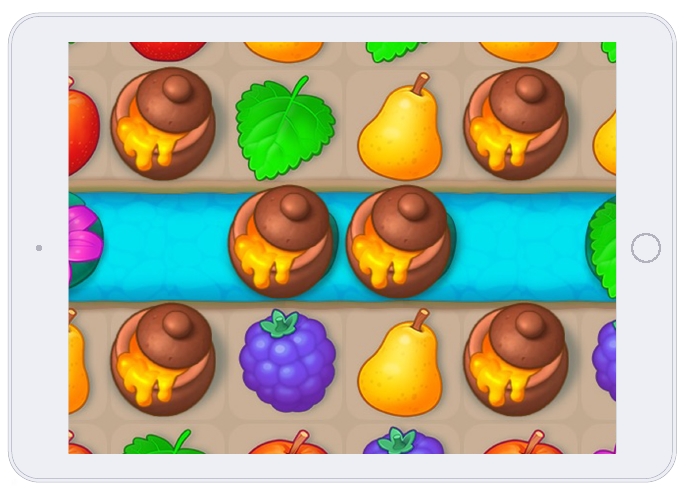
What is the problem?
When a player makes a match next to a jar of honey, it explodes and scatters honey around itself. And at the level, such a situation may arise when this honey pours a water lily. Then it turns out that the water lily, small and neatly inscribed in the tile, moves this big, big tile of honey. It doesn’t look very nice. We decided to abandon such a combination in order not to lead the player into a dead end once again, so that he feels comfortable at the level and always understands, in fact, what is happening.
Level design errors
Let’s look at a couple more examples of errors that we encountered during the development phase.
Useless areas on the field
At the level just below, the player must collect flowers by making matches next to the flowerbed. Here it is – in the middle of the level.
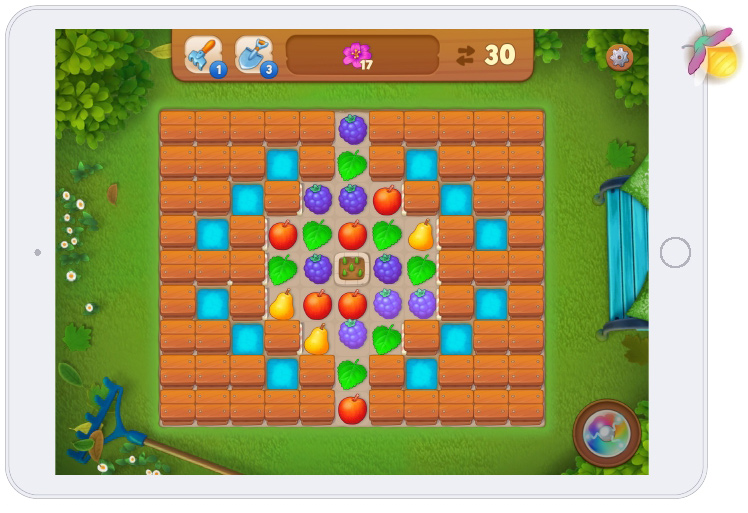
The topology of the level assumes that the player will interact only with the central part. Of course, he can destroy the boxes and free up the corner zones. But matches in these zones will not lead him to victory. That is, they will not affect the real goal of the level in any way. Therefore, in this case, the level is considered bad, because it is concentrated in the center, and the edges are not used, as it were. These are the levels best avoided. If you like the idea of this level, you can rebuild it a little bit, so as to use all the space.
Useless goal
This error is well revealed by the next level:
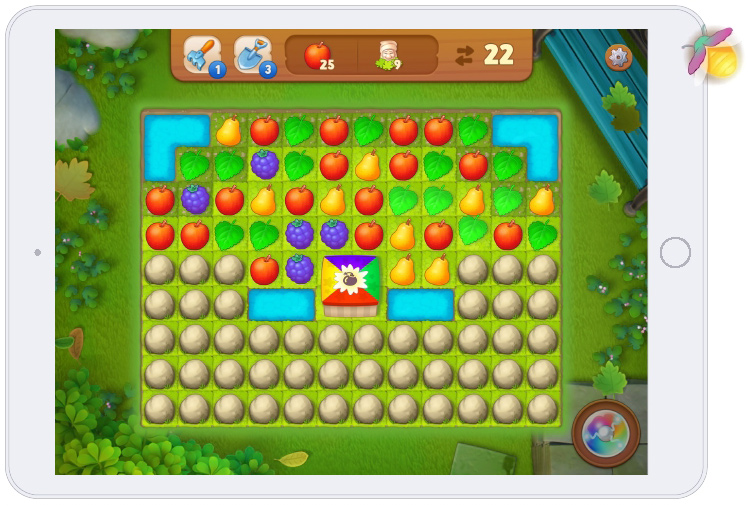
At this level, the player has a task – to collect apples and collect dwarfs.
Already looking at the screenshot, it becomes clear that the level is quite difficult, the player will need to do a lot of matches, a lot of explosions. Here, working with dwarves, the player completes the target for apples automatically. It’s just a useless goal. On the one hand, it doesn’t seem to spoil anything, the player will fulfill it, everyone is happy. But in real conditions, we will defocus the player’s attention here. It is better that he knows what exactly he needs to do. And this clearly set task and the precise execution of this task will create a pleasant impression for the player.
The funny thing is that when I was making these slides, making a presentation and simultaneously checking the levels that we are just going to lay out, I found such a problem in a fresh pack. A very banal mistake, it was caught a bunch of times, and all level designers are aware of this situation, but in reality, even after a year of playing, we sometimes encounter this.
Lack of available seats for purchased bonuses
It’s no secret that the player can buy bonuses at the start of the level, and these bonuses will appear when the level appears on the screen. Now pay attention to the picture below.
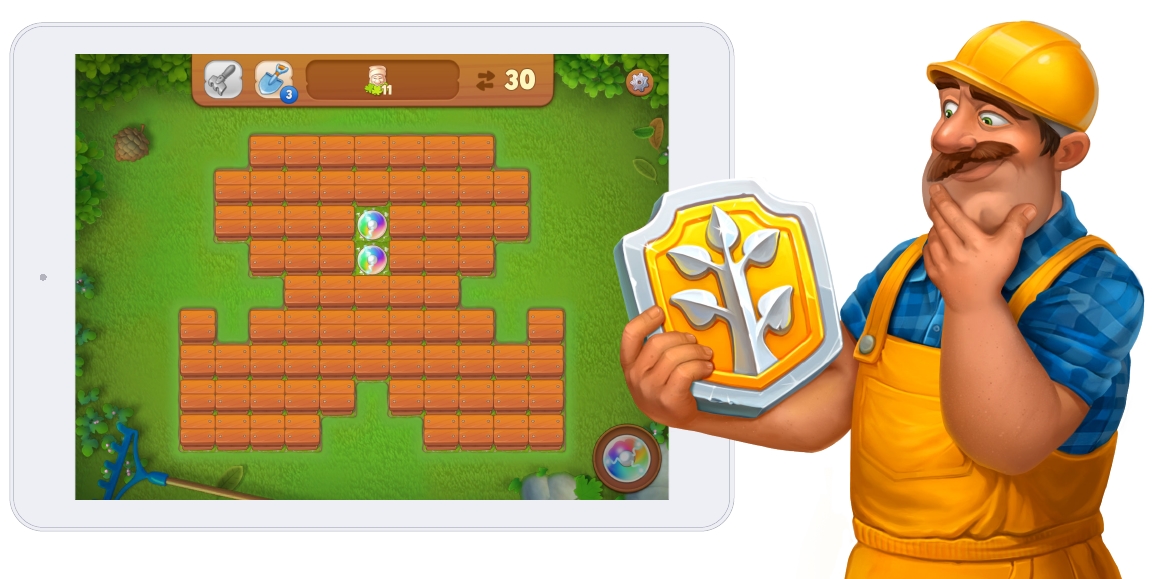
In this case, there are no free places where the bonus could appear. Of course, there is a simple option: to replace one of the blockers with the purchased bonus, in this case, a box. But in reality, this can lead to a breakdown of the logic of the level. It may even become impassable. Therefore, we adopted a simple rule: at the start of each match-3 level, there should be five empty tiles, into which five bonuses purchased on the briefing screen can “fly”.
Passing in one move
A difficult situation. And it requires a complex example.
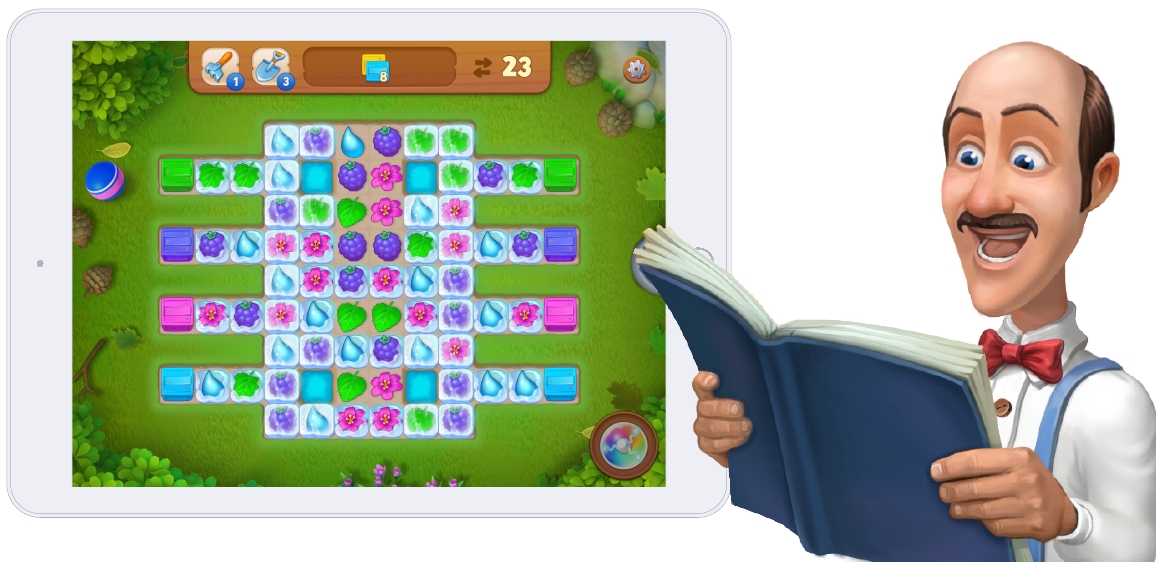
The player has a goal – to collect eight boxes. At the start of the level, there are very few free zones where these five purchased bonuses can “fly”. And the chance that the purchased two “zippers” will be next to each other is very large.
It turns out that the player gets these two “lightning bolts”, he combines them, the wave destroys eight boxes, and the level is passed. It is passed in one move.
It may seem that there is nothing wrong with this. But in fact, we deprive the player of the pleasure of passing the level: he uses bonuses not as an auxiliary, facilitating element, but as a cheat that allows you to pass the level simply by using the level designer’s mistake.
We believe that this is wrong, and we try to avoid such situations.
Tips for working on levels
To see ideas at the level, you need to have quite a lot of experience developing match-3 games, a lot of gaming experience in such titles, and, in addition, you need to constantly develop your skills as a level designer in order to find relevant fresh ideas in new games.
How to develop the skills of a level designer?
First of all, you need to love match-3 games, but just playing them is not enough, because one game is of little use. You need to analyze everything that you see, what you encounter. Maybe even write it down.
What is worth looking at in the games of competitors:
- Entering elements. How your competitors introduce elements, how blockers are introduced, how auxiliary elements look in their games. Perhaps their order is more interesting than in your game, and in this case the player gets more unique combinations than you have.
- Entering level goals. What the player does at the level: what orders he executes, what items he displays and what he collects.
- Combinations of elements. You need to look at who and what combines with what. In order to understand this topic, the King company’s games are great: Candy Crush Saga, Candy Crush Soda Saga. They have a combination of elements very well – pay attention when you look.
- Interesting ideas on the level. You already need to have some experience here, you need some kind of base. But in principle, when you start analyzing, you will begin to notice these interesting ideas. You can describe to yourself directly, you know, what you saw, so that you can use it in your work later.
- Setting and visualization. It is also a very important parameter that allows you to evaluate the creativity of level designers. Maybe they collected some interesting picture there, as in the example of the hare, maybe they came up with something else.
- Your personal feelings about the game. Try to capture and record, because it is very important. If you experience certain sensations, then the player can then experience something similar. If you are attracted to it, you like it, then he may like it too.
All this is independent work. After you have done the analysis yourself, systematized and recorded everything for yourself, it is very important to start communicating with your team, hold some joint meetings, discussions, show your ideas of good developments, show other people’s ideas. This allows you to grow not only you, but also your entire team. And all this in total affects the success of the game.
And, actually, a few points that allow you to make a good match-3 level. Need:
- come up with a good idea that you will like, that will be understandable to the player;
- pick up elements or combinations of elements that you will use at this level to reveal the idea even better;
- after you make this level, you need to test it to find some weak points that can spoil the feeling of the level or the logic of the level.
These are the main steps to take when preparing a cool level.